Communication Skills in Business: Models, Methods, and Barriers
VerifiedAdded on 2020/11/12
|17
|4415
|437
Report
AI Summary
This report delves into the crucial role of communication skills within a business environment. It begins by outlining various communication models, such as the Shannon and Weaver Model, Berlo's Model, and Schramm's Model, along with different communication systems including optical, duplex, and radio systems. The report then explores diverse communication methods like verbal, written, non-verbal, visual, and electronic communication, highlighting the advantages of both formal and informal communication channels. Furthermore, it examines the application of communication technology in business, particularly in product launches and surveys. The report also emphasizes the principles of effective communication, such as clarity, objectivity, and feedback, while also identifying and analyzing barriers to effective communication, including external barriers like lack of attention. The report offers a comprehensive overview of communication strategies essential for business success.
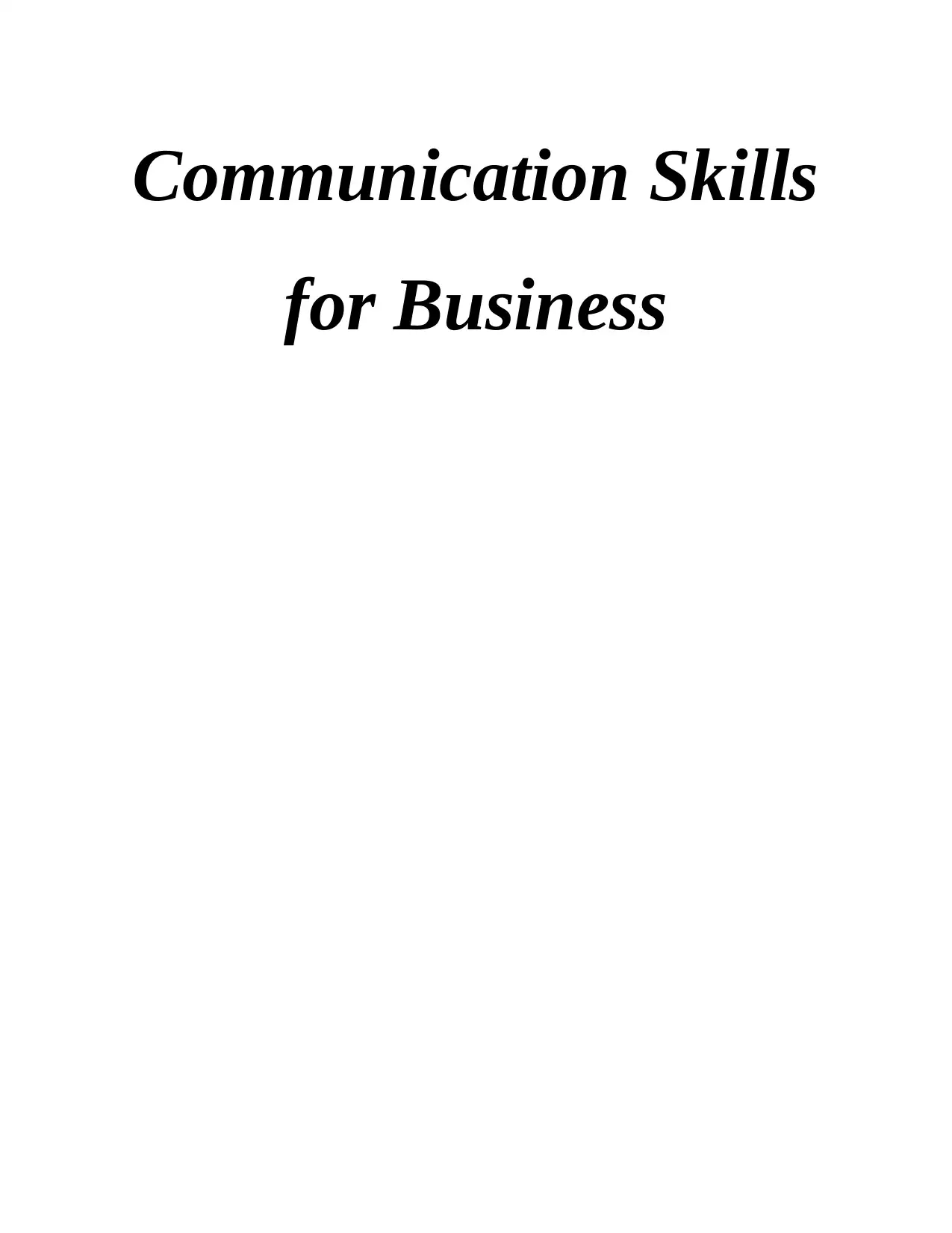
Communication Skills
for Business
for Business
Paraphrase This Document
Need a fresh take? Get an instant paraphrase of this document with our AI Paraphraser
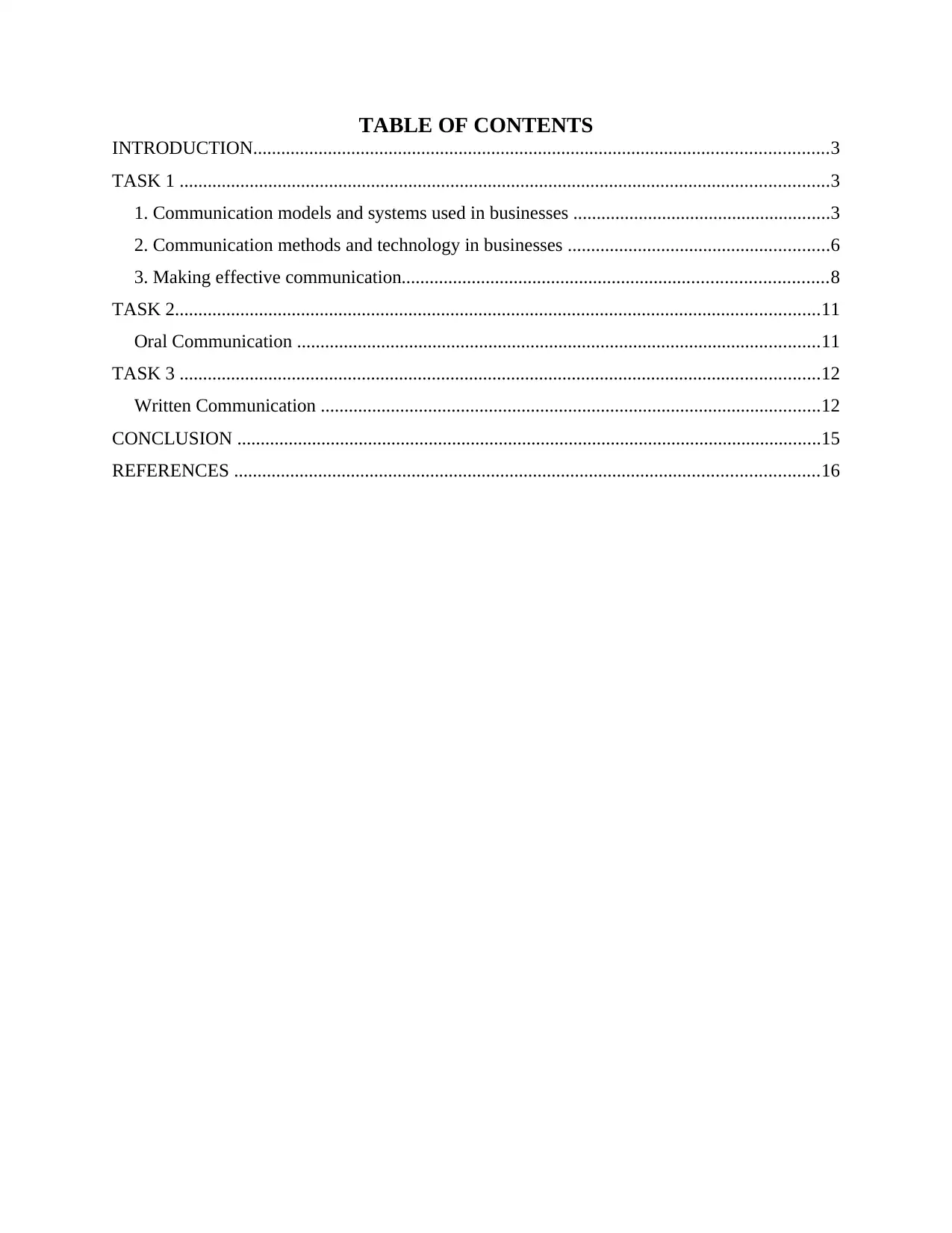
TABLE OF CONTENTS
INTRODUCTION...........................................................................................................................3
TASK 1 ...........................................................................................................................................3
1. Communication models and systems used in businesses .......................................................3
2. Communication methods and technology in businesses ........................................................6
3. Making effective communication...........................................................................................8
TASK 2..........................................................................................................................................11
Oral Communication ................................................................................................................11
TASK 3 .........................................................................................................................................12
Written Communication ...........................................................................................................12
CONCLUSION .............................................................................................................................15
REFERENCES .............................................................................................................................16
INTRODUCTION...........................................................................................................................3
TASK 1 ...........................................................................................................................................3
1. Communication models and systems used in businesses .......................................................3
2. Communication methods and technology in businesses ........................................................6
3. Making effective communication...........................................................................................8
TASK 2..........................................................................................................................................11
Oral Communication ................................................................................................................11
TASK 3 .........................................................................................................................................12
Written Communication ...........................................................................................................12
CONCLUSION .............................................................................................................................15
REFERENCES .............................................................................................................................16
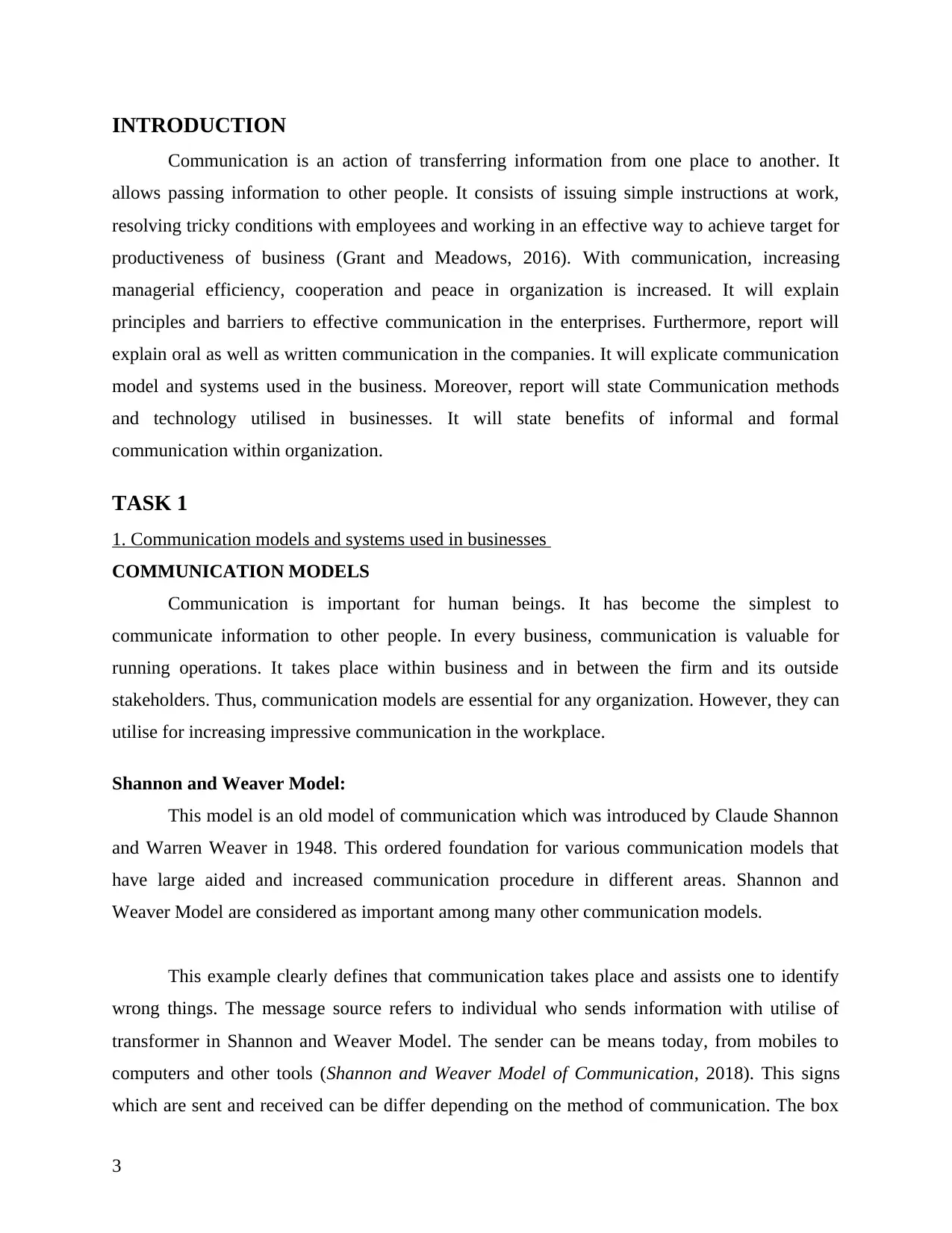
INTRODUCTION
Communication is an action of transferring information from one place to another. It
allows passing information to other people. It consists of issuing simple instructions at work,
resolving tricky conditions with employees and working in an effective way to achieve target for
productiveness of business (Grant and Meadows, 2016). With communication, increasing
managerial efficiency, cooperation and peace in organization is increased. It will explain
principles and barriers to effective communication in the enterprises. Furthermore, report will
explain oral as well as written communication in the companies. It will explicate communication
model and systems used in the business. Moreover, report will state Communication methods
and technology utilised in businesses. It will state benefits of informal and formal
communication within organization.
TASK 1
1. Communication models and systems used in businesses
COMMUNICATION MODELS
Communication is important for human beings. It has become the simplest to
communicate information to other people. In every business, communication is valuable for
running operations. It takes place within business and in between the firm and its outside
stakeholders. Thus, communication models are essential for any organization. However, they can
utilise for increasing impressive communication in the workplace.
Shannon and Weaver Model:
This model is an old model of communication which was introduced by Claude Shannon
and Warren Weaver in 1948. This ordered foundation for various communication models that
have large aided and increased communication procedure in different areas. Shannon and
Weaver Model are considered as important among many other communication models.
This example clearly defines that communication takes place and assists one to identify
wrong things. The message source refers to individual who sends information with utilise of
transformer in Shannon and Weaver Model. The sender can be means today, from mobiles to
computers and other tools (Shannon and Weaver Model of Communication, 2018). This signs
which are sent and received can be differ depending on the method of communication. The box
3
Communication is an action of transferring information from one place to another. It
allows passing information to other people. It consists of issuing simple instructions at work,
resolving tricky conditions with employees and working in an effective way to achieve target for
productiveness of business (Grant and Meadows, 2016). With communication, increasing
managerial efficiency, cooperation and peace in organization is increased. It will explain
principles and barriers to effective communication in the enterprises. Furthermore, report will
explain oral as well as written communication in the companies. It will explicate communication
model and systems used in the business. Moreover, report will state Communication methods
and technology utilised in businesses. It will state benefits of informal and formal
communication within organization.
TASK 1
1. Communication models and systems used in businesses
COMMUNICATION MODELS
Communication is important for human beings. It has become the simplest to
communicate information to other people. In every business, communication is valuable for
running operations. It takes place within business and in between the firm and its outside
stakeholders. Thus, communication models are essential for any organization. However, they can
utilise for increasing impressive communication in the workplace.
Shannon and Weaver Model:
This model is an old model of communication which was introduced by Claude Shannon
and Warren Weaver in 1948. This ordered foundation for various communication models that
have large aided and increased communication procedure in different areas. Shannon and
Weaver Model are considered as important among many other communication models.
This example clearly defines that communication takes place and assists one to identify
wrong things. The message source refers to individual who sends information with utilise of
transformer in Shannon and Weaver Model. The sender can be means today, from mobiles to
computers and other tools (Shannon and Weaver Model of Communication, 2018). This signs
which are sent and received can be differ depending on the method of communication. The box
3
⊘ This is a preview!⊘
Do you want full access?
Subscribe today to unlock all pages.

Trusted by 1+ million students worldwide
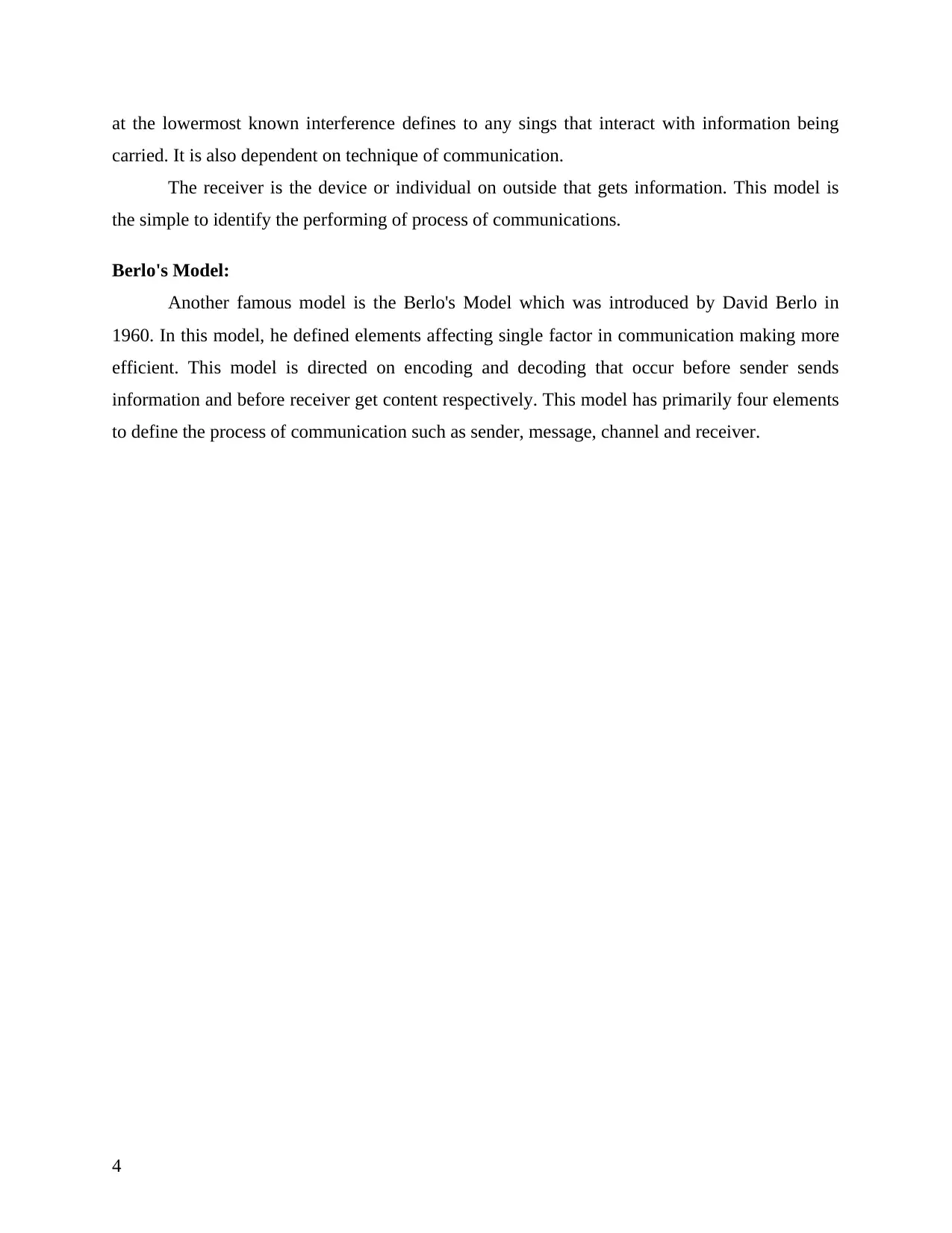
at the lowermost known interference defines to any sings that interact with information being
carried. It is also dependent on technique of communication.
The receiver is the device or individual on outside that gets information. This model is
the simple to identify the performing of process of communications.
Berlo's Model:
Another famous model is the Berlo's Model which was introduced by David Berlo in
1960. In this model, he defined elements affecting single factor in communication making more
efficient. This model is directed on encoding and decoding that occur before sender sends
information and before receiver get content respectively. This model has primarily four elements
to define the process of communication such as sender, message, channel and receiver.
4
carried. It is also dependent on technique of communication.
The receiver is the device or individual on outside that gets information. This model is
the simple to identify the performing of process of communications.
Berlo's Model:
Another famous model is the Berlo's Model which was introduced by David Berlo in
1960. In this model, he defined elements affecting single factor in communication making more
efficient. This model is directed on encoding and decoding that occur before sender sends
information and before receiver get content respectively. This model has primarily four elements
to define the process of communication such as sender, message, channel and receiver.
4
Paraphrase This Document
Need a fresh take? Get an instant paraphrase of this document with our AI Paraphraser
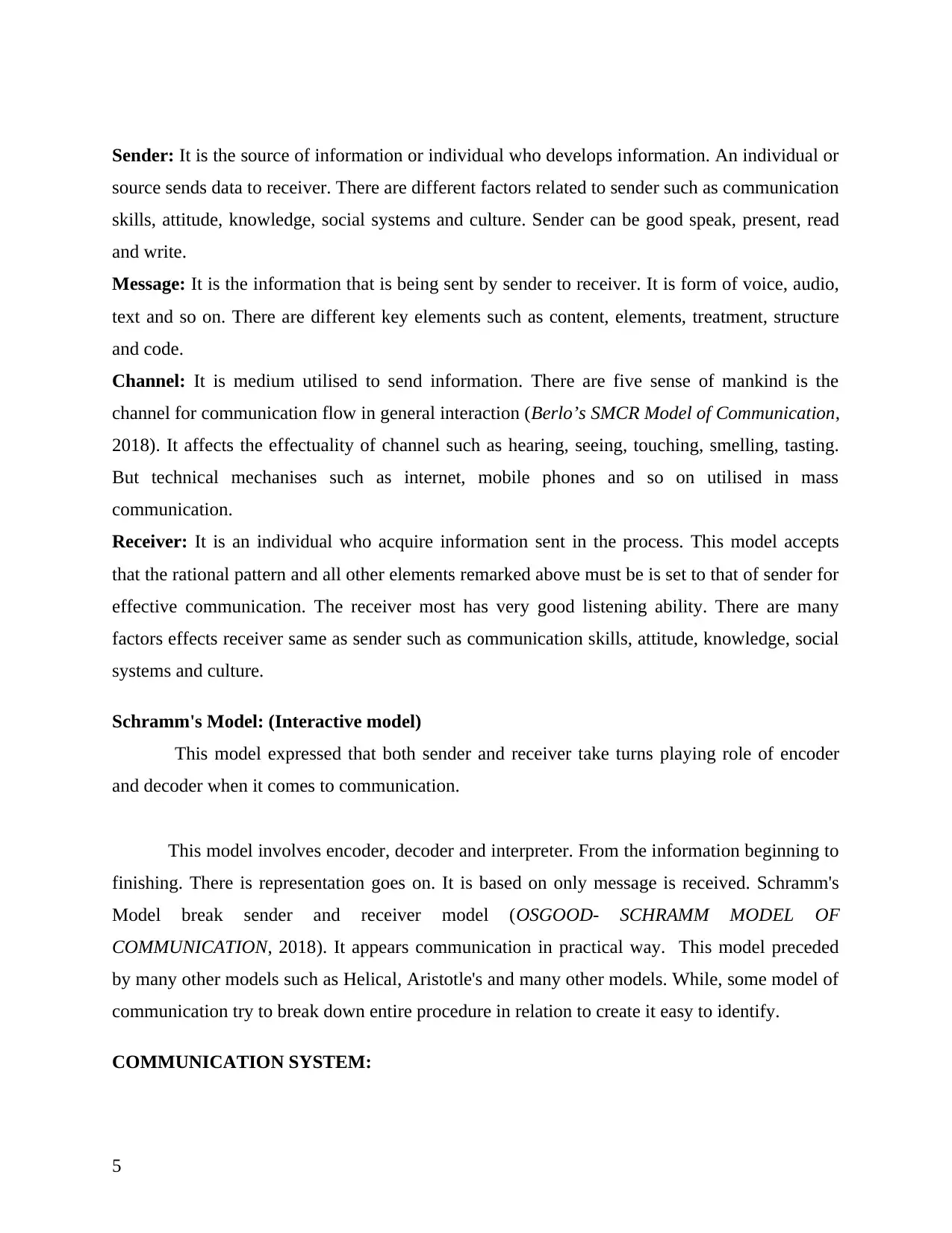
Sender: It is the source of information or individual who develops information. An individual or
source sends data to receiver. There are different factors related to sender such as communication
skills, attitude, knowledge, social systems and culture. Sender can be good speak, present, read
and write.
Message: It is the information that is being sent by sender to receiver. It is form of voice, audio,
text and so on. There are different key elements such as content, elements, treatment, structure
and code.
Channel: It is medium utilised to send information. There are five sense of mankind is the
channel for communication flow in general interaction (Berlo’s SMCR Model of Communication,
2018). It affects the effectuality of channel such as hearing, seeing, touching, smelling, tasting.
But technical mechanises such as internet, mobile phones and so on utilised in mass
communication.
Receiver: It is an individual who acquire information sent in the process. This model accepts
that the rational pattern and all other elements remarked above must be is set to that of sender for
effective communication. The receiver most has very good listening ability. There are many
factors effects receiver same as sender such as communication skills, attitude, knowledge, social
systems and culture.
Schramm's Model: (Interactive model)
This model expressed that both sender and receiver take turns playing role of encoder
and decoder when it comes to communication.
This model involves encoder, decoder and interpreter. From the information beginning to
finishing. There is representation goes on. It is based on only message is received. Schramm's
Model break sender and receiver model (OSGOOD- SCHRAMM MODEL OF
COMMUNICATION, 2018). It appears communication in practical way. This model preceded
by many other models such as Helical, Aristotle's and many other models. While, some model of
communication try to break down entire procedure in relation to create it easy to identify.
COMMUNICATION SYSTEM:
5
source sends data to receiver. There are different factors related to sender such as communication
skills, attitude, knowledge, social systems and culture. Sender can be good speak, present, read
and write.
Message: It is the information that is being sent by sender to receiver. It is form of voice, audio,
text and so on. There are different key elements such as content, elements, treatment, structure
and code.
Channel: It is medium utilised to send information. There are five sense of mankind is the
channel for communication flow in general interaction (Berlo’s SMCR Model of Communication,
2018). It affects the effectuality of channel such as hearing, seeing, touching, smelling, tasting.
But technical mechanises such as internet, mobile phones and so on utilised in mass
communication.
Receiver: It is an individual who acquire information sent in the process. This model accepts
that the rational pattern and all other elements remarked above must be is set to that of sender for
effective communication. The receiver most has very good listening ability. There are many
factors effects receiver same as sender such as communication skills, attitude, knowledge, social
systems and culture.
Schramm's Model: (Interactive model)
This model expressed that both sender and receiver take turns playing role of encoder
and decoder when it comes to communication.
This model involves encoder, decoder and interpreter. From the information beginning to
finishing. There is representation goes on. It is based on only message is received. Schramm's
Model break sender and receiver model (OSGOOD- SCHRAMM MODEL OF
COMMUNICATION, 2018). It appears communication in practical way. This model preceded
by many other models such as Helical, Aristotle's and many other models. While, some model of
communication try to break down entire procedure in relation to create it easy to identify.
COMMUNICATION SYSTEM:
5
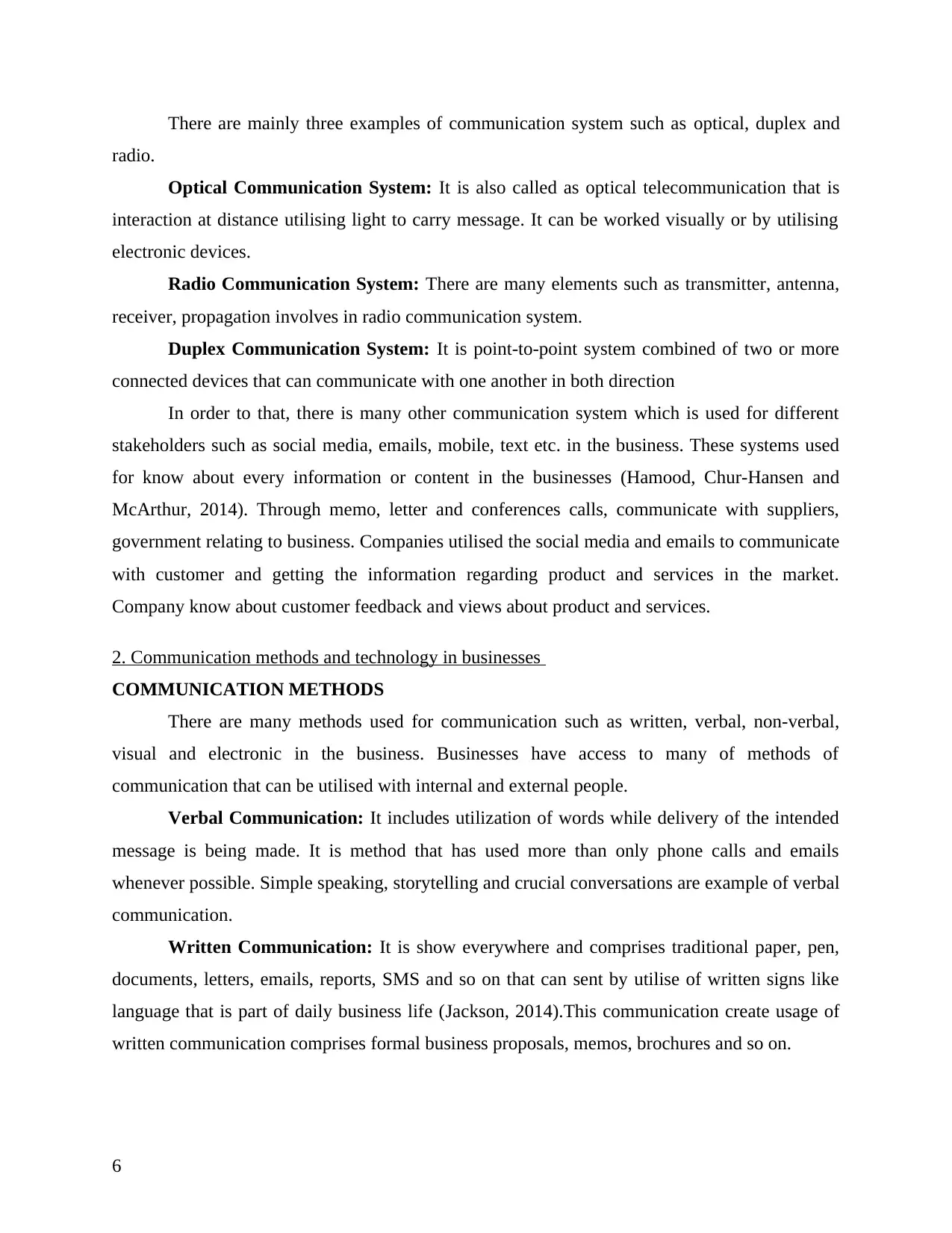
There are mainly three examples of communication system such as optical, duplex and
radio.
Optical Communication System: It is also called as optical telecommunication that is
interaction at distance utilising light to carry message. It can be worked visually or by utilising
electronic devices.
Radio Communication System: There are many elements such as transmitter, antenna,
receiver, propagation involves in radio communication system.
Duplex Communication System: It is point-to-point system combined of two or more
connected devices that can communicate with one another in both direction
In order to that, there is many other communication system which is used for different
stakeholders such as social media, emails, mobile, text etc. in the business. These systems used
for know about every information or content in the businesses (Hamood, Chur-Hansen and
McArthur, 2014). Through memo, letter and conferences calls, communicate with suppliers,
government relating to business. Companies utilised the social media and emails to communicate
with customer and getting the information regarding product and services in the market.
Company know about customer feedback and views about product and services.
2. Communication methods and technology in businesses
COMMUNICATION METHODS
There are many methods used for communication such as written, verbal, non-verbal,
visual and electronic in the business. Businesses have access to many of methods of
communication that can be utilised with internal and external people.
Verbal Communication: It includes utilization of words while delivery of the intended
message is being made. It is method that has used more than only phone calls and emails
whenever possible. Simple speaking, storytelling and crucial conversations are example of verbal
communication.
Written Communication: It is show everywhere and comprises traditional paper, pen,
documents, letters, emails, reports, SMS and so on that can sent by utilise of written signs like
language that is part of daily business life (Jackson, 2014).This communication create usage of
written communication comprises formal business proposals, memos, brochures and so on.
6
radio.
Optical Communication System: It is also called as optical telecommunication that is
interaction at distance utilising light to carry message. It can be worked visually or by utilising
electronic devices.
Radio Communication System: There are many elements such as transmitter, antenna,
receiver, propagation involves in radio communication system.
Duplex Communication System: It is point-to-point system combined of two or more
connected devices that can communicate with one another in both direction
In order to that, there is many other communication system which is used for different
stakeholders such as social media, emails, mobile, text etc. in the business. These systems used
for know about every information or content in the businesses (Hamood, Chur-Hansen and
McArthur, 2014). Through memo, letter and conferences calls, communicate with suppliers,
government relating to business. Companies utilised the social media and emails to communicate
with customer and getting the information regarding product and services in the market.
Company know about customer feedback and views about product and services.
2. Communication methods and technology in businesses
COMMUNICATION METHODS
There are many methods used for communication such as written, verbal, non-verbal,
visual and electronic in the business. Businesses have access to many of methods of
communication that can be utilised with internal and external people.
Verbal Communication: It includes utilization of words while delivery of the intended
message is being made. It is method that has used more than only phone calls and emails
whenever possible. Simple speaking, storytelling and crucial conversations are example of verbal
communication.
Written Communication: It is show everywhere and comprises traditional paper, pen,
documents, letters, emails, reports, SMS and so on that can sent by utilise of written signs like
language that is part of daily business life (Jackson, 2014).This communication create usage of
written communication comprises formal business proposals, memos, brochures and so on.
6
⊘ This is a preview!⊘
Do you want full access?
Subscribe today to unlock all pages.

Trusted by 1+ million students worldwide
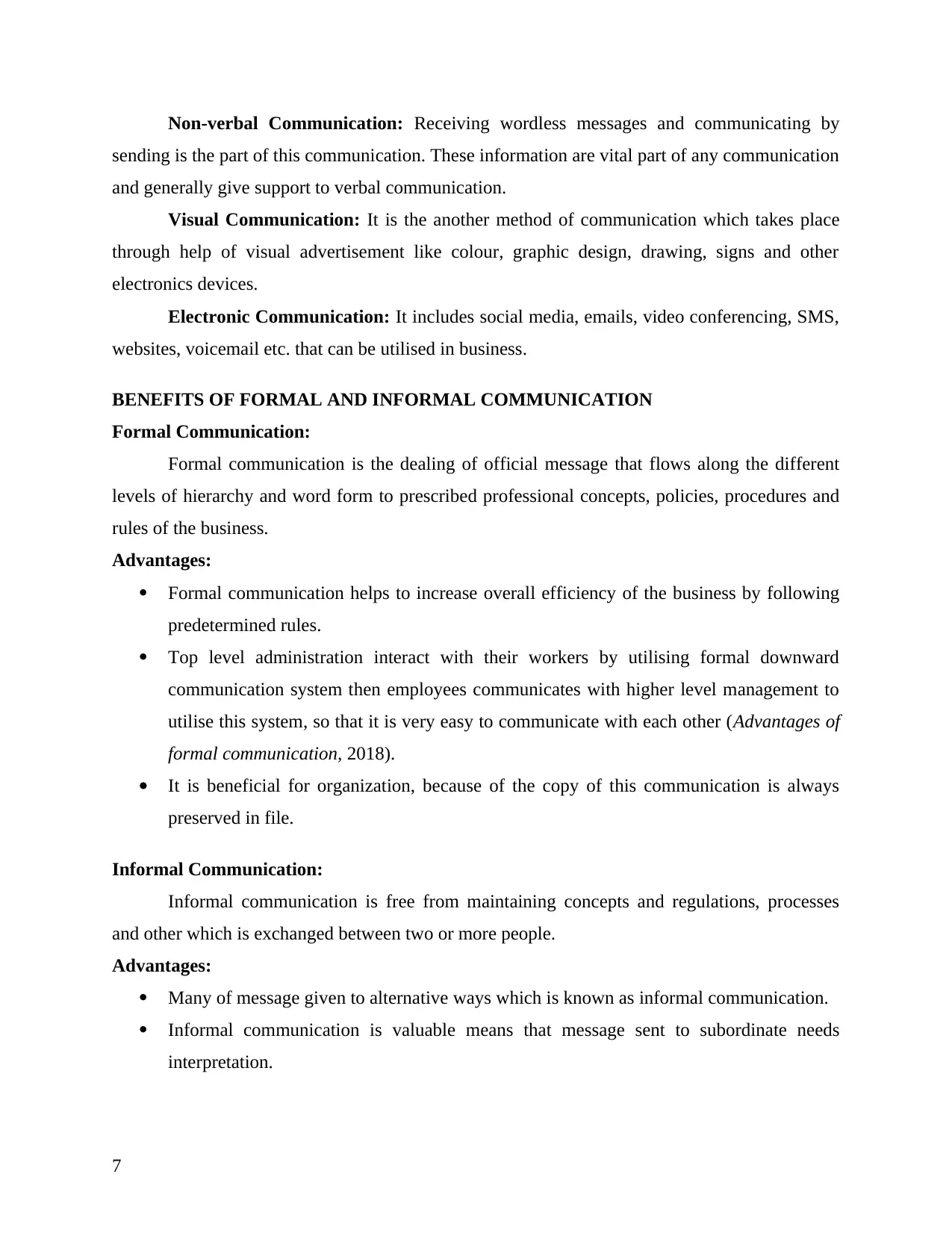
Non-verbal Communication: Receiving wordless messages and communicating by
sending is the part of this communication. These information are vital part of any communication
and generally give support to verbal communication.
Visual Communication: It is the another method of communication which takes place
through help of visual advertisement like colour, graphic design, drawing, signs and other
electronics devices.
Electronic Communication: It includes social media, emails, video conferencing, SMS,
websites, voicemail etc. that can be utilised in business.
BENEFITS OF FORMAL AND INFORMAL COMMUNICATION
Formal Communication:
Formal communication is the dealing of official message that flows along the different
levels of hierarchy and word form to prescribed professional concepts, policies, procedures and
rules of the business.
Advantages:
Formal communication helps to increase overall efficiency of the business by following
predetermined rules.
Top level administration interact with their workers by utilising formal downward
communication system then employees communicates with higher level management to
utilise this system, so that it is very easy to communicate with each other (Advantages of
formal communication, 2018).
It is beneficial for organization, because of the copy of this communication is always
preserved in file.
Informal Communication:
Informal communication is free from maintaining concepts and regulations, processes
and other which is exchanged between two or more people.
Advantages:
Many of message given to alternative ways which is known as informal communication.
Informal communication is valuable means that message sent to subordinate needs
interpretation.
7
sending is the part of this communication. These information are vital part of any communication
and generally give support to verbal communication.
Visual Communication: It is the another method of communication which takes place
through help of visual advertisement like colour, graphic design, drawing, signs and other
electronics devices.
Electronic Communication: It includes social media, emails, video conferencing, SMS,
websites, voicemail etc. that can be utilised in business.
BENEFITS OF FORMAL AND INFORMAL COMMUNICATION
Formal Communication:
Formal communication is the dealing of official message that flows along the different
levels of hierarchy and word form to prescribed professional concepts, policies, procedures and
rules of the business.
Advantages:
Formal communication helps to increase overall efficiency of the business by following
predetermined rules.
Top level administration interact with their workers by utilising formal downward
communication system then employees communicates with higher level management to
utilise this system, so that it is very easy to communicate with each other (Advantages of
formal communication, 2018).
It is beneficial for organization, because of the copy of this communication is always
preserved in file.
Informal Communication:
Informal communication is free from maintaining concepts and regulations, processes
and other which is exchanged between two or more people.
Advantages:
Many of message given to alternative ways which is known as informal communication.
Informal communication is valuable means that message sent to subordinate needs
interpretation.
7
Paraphrase This Document
Need a fresh take? Get an instant paraphrase of this document with our AI Paraphraser
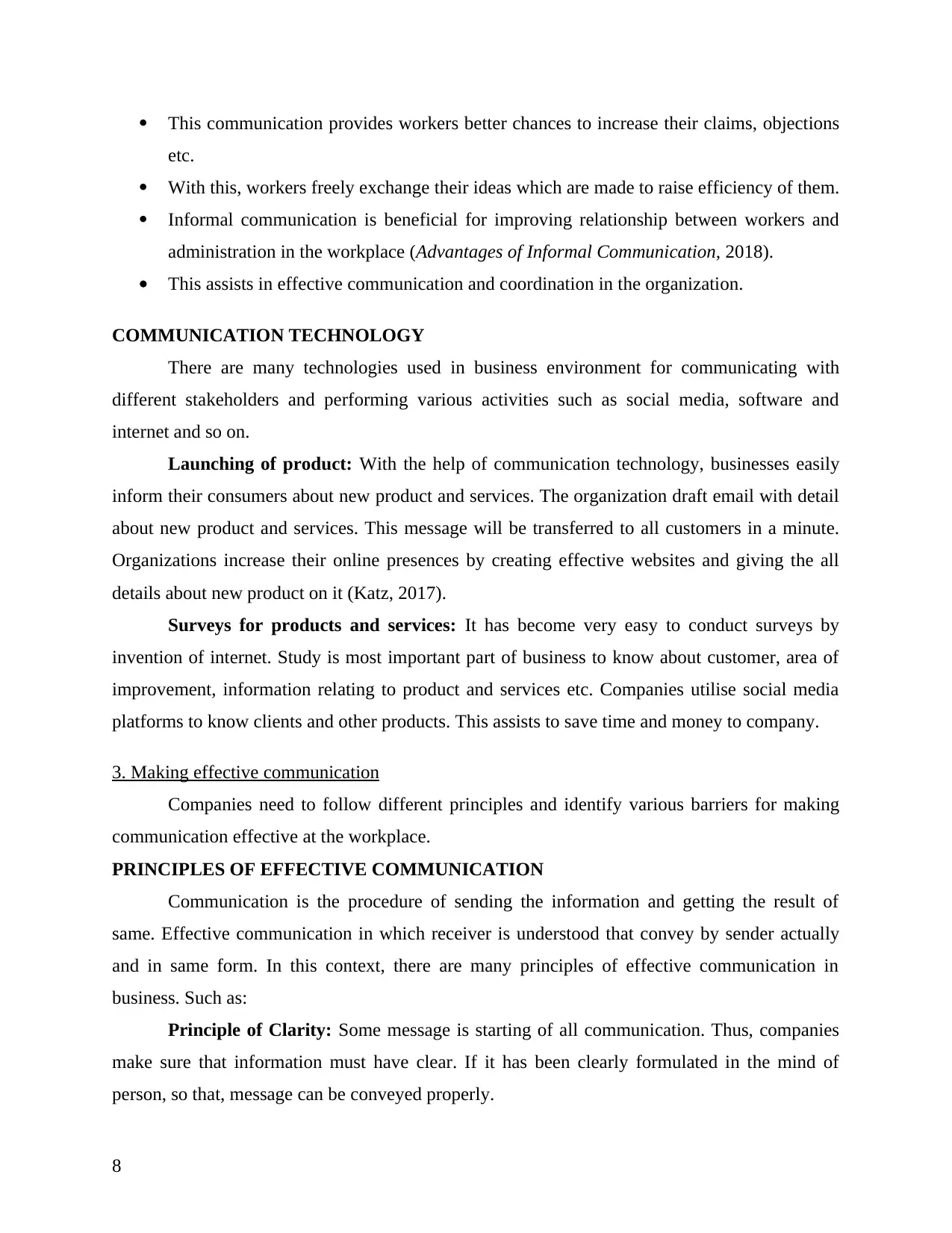
This communication provides workers better chances to increase their claims, objections
etc.
With this, workers freely exchange their ideas which are made to raise efficiency of them.
Informal communication is beneficial for improving relationship between workers and
administration in the workplace (Advantages of Informal Communication, 2018).
This assists in effective communication and coordination in the organization.
COMMUNICATION TECHNOLOGY
There are many technologies used in business environment for communicating with
different stakeholders and performing various activities such as social media, software and
internet and so on.
Launching of product: With the help of communication technology, businesses easily
inform their consumers about new product and services. The organization draft email with detail
about new product and services. This message will be transferred to all customers in a minute.
Organizations increase their online presences by creating effective websites and giving the all
details about new product on it (Katz, 2017).
Surveys for products and services: It has become very easy to conduct surveys by
invention of internet. Study is most important part of business to know about customer, area of
improvement, information relating to product and services etc. Companies utilise social media
platforms to know clients and other products. This assists to save time and money to company.
3. Making effective communication
Companies need to follow different principles and identify various barriers for making
communication effective at the workplace.
PRINCIPLES OF EFFECTIVE COMMUNICATION
Communication is the procedure of sending the information and getting the result of
same. Effective communication in which receiver is understood that convey by sender actually
and in same form. In this context, there are many principles of effective communication in
business. Such as:
Principle of Clarity: Some message is starting of all communication. Thus, companies
make sure that information must have clear. If it has been clearly formulated in the mind of
person, so that, message can be conveyed properly.
8
etc.
With this, workers freely exchange their ideas which are made to raise efficiency of them.
Informal communication is beneficial for improving relationship between workers and
administration in the workplace (Advantages of Informal Communication, 2018).
This assists in effective communication and coordination in the organization.
COMMUNICATION TECHNOLOGY
There are many technologies used in business environment for communicating with
different stakeholders and performing various activities such as social media, software and
internet and so on.
Launching of product: With the help of communication technology, businesses easily
inform their consumers about new product and services. The organization draft email with detail
about new product and services. This message will be transferred to all customers in a minute.
Organizations increase their online presences by creating effective websites and giving the all
details about new product on it (Katz, 2017).
Surveys for products and services: It has become very easy to conduct surveys by
invention of internet. Study is most important part of business to know about customer, area of
improvement, information relating to product and services etc. Companies utilise social media
platforms to know clients and other products. This assists to save time and money to company.
3. Making effective communication
Companies need to follow different principles and identify various barriers for making
communication effective at the workplace.
PRINCIPLES OF EFFECTIVE COMMUNICATION
Communication is the procedure of sending the information and getting the result of
same. Effective communication in which receiver is understood that convey by sender actually
and in same form. In this context, there are many principles of effective communication in
business. Such as:
Principle of Clarity: Some message is starting of all communication. Thus, companies
make sure that information must have clear. If it has been clearly formulated in the mind of
person, so that, message can be conveyed properly.
8
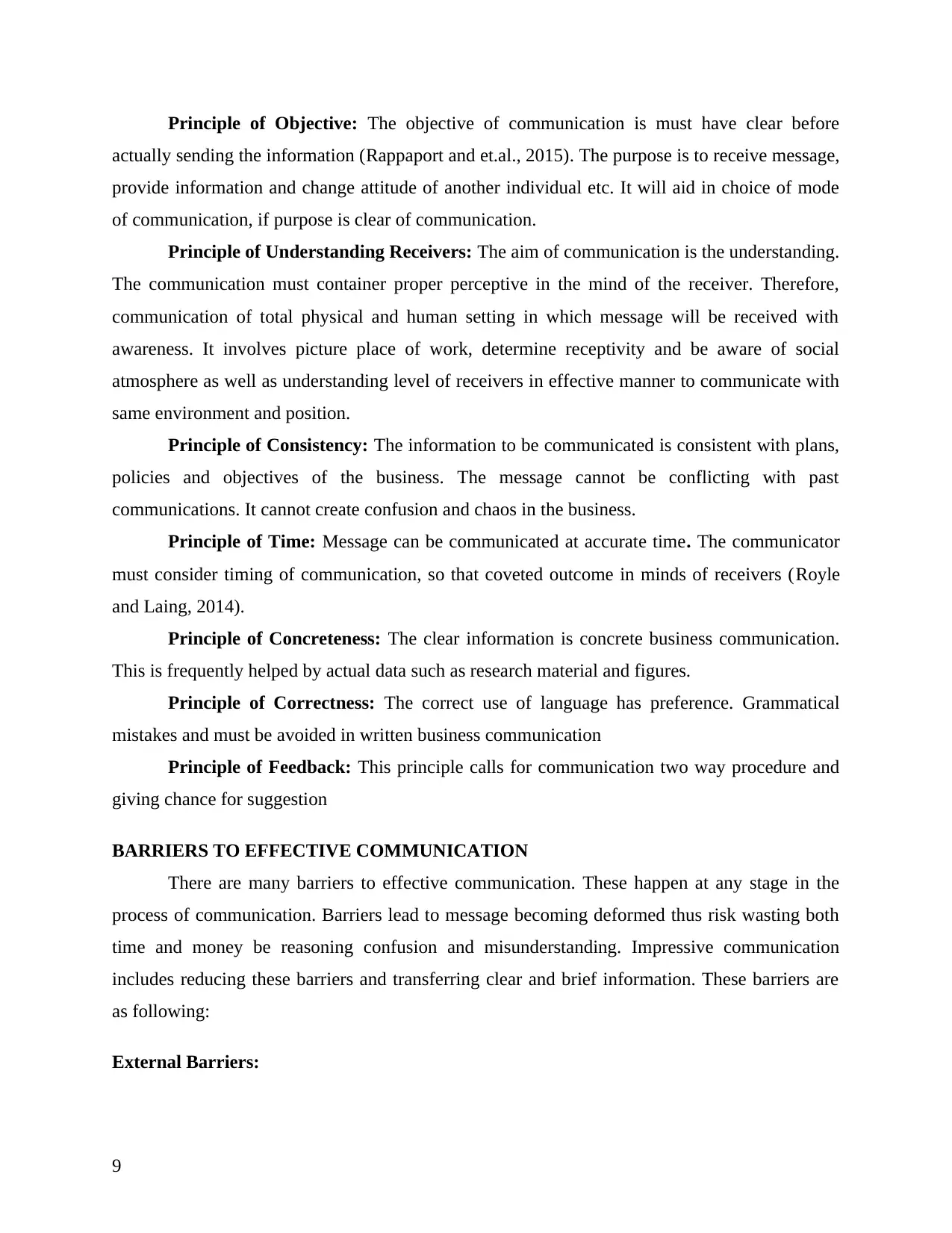
Principle of Objective: The objective of communication is must have clear before
actually sending the information (Rappaport and et.al., 2015). The purpose is to receive message,
provide information and change attitude of another individual etc. It will aid in choice of mode
of communication, if purpose is clear of communication.
Principle of Understanding Receivers: The aim of communication is the understanding.
The communication must container proper perceptive in the mind of the receiver. Therefore,
communication of total physical and human setting in which message will be received with
awareness. It involves picture place of work, determine receptivity and be aware of social
atmosphere as well as understanding level of receivers in effective manner to communicate with
same environment and position.
Principle of Consistency: The information to be communicated is consistent with plans,
policies and objectives of the business. The message cannot be conflicting with past
communications. It cannot create confusion and chaos in the business.
Principle of Time: Message can be communicated at accurate time. The communicator
must consider timing of communication, so that coveted outcome in minds of receivers (Royle
and Laing, 2014).
Principle of Concreteness: The clear information is concrete business communication.
This is frequently helped by actual data such as research material and figures.
Principle of Correctness: The correct use of language has preference. Grammatical
mistakes and must be avoided in written business communication
Principle of Feedback: This principle calls for communication two way procedure and
giving chance for suggestion
BARRIERS TO EFFECTIVE COMMUNICATION
There are many barriers to effective communication. These happen at any stage in the
process of communication. Barriers lead to message becoming deformed thus risk wasting both
time and money be reasoning confusion and misunderstanding. Impressive communication
includes reducing these barriers and transferring clear and brief information. These barriers are
as following:
External Barriers:
9
actually sending the information (Rappaport and et.al., 2015). The purpose is to receive message,
provide information and change attitude of another individual etc. It will aid in choice of mode
of communication, if purpose is clear of communication.
Principle of Understanding Receivers: The aim of communication is the understanding.
The communication must container proper perceptive in the mind of the receiver. Therefore,
communication of total physical and human setting in which message will be received with
awareness. It involves picture place of work, determine receptivity and be aware of social
atmosphere as well as understanding level of receivers in effective manner to communicate with
same environment and position.
Principle of Consistency: The information to be communicated is consistent with plans,
policies and objectives of the business. The message cannot be conflicting with past
communications. It cannot create confusion and chaos in the business.
Principle of Time: Message can be communicated at accurate time. The communicator
must consider timing of communication, so that coveted outcome in minds of receivers (Royle
and Laing, 2014).
Principle of Concreteness: The clear information is concrete business communication.
This is frequently helped by actual data such as research material and figures.
Principle of Correctness: The correct use of language has preference. Grammatical
mistakes and must be avoided in written business communication
Principle of Feedback: This principle calls for communication two way procedure and
giving chance for suggestion
BARRIERS TO EFFECTIVE COMMUNICATION
There are many barriers to effective communication. These happen at any stage in the
process of communication. Barriers lead to message becoming deformed thus risk wasting both
time and money be reasoning confusion and misunderstanding. Impressive communication
includes reducing these barriers and transferring clear and brief information. These barriers are
as following:
External Barriers:
9
⊘ This is a preview!⊘
Do you want full access?
Subscribe today to unlock all pages.

Trusted by 1+ million students worldwide
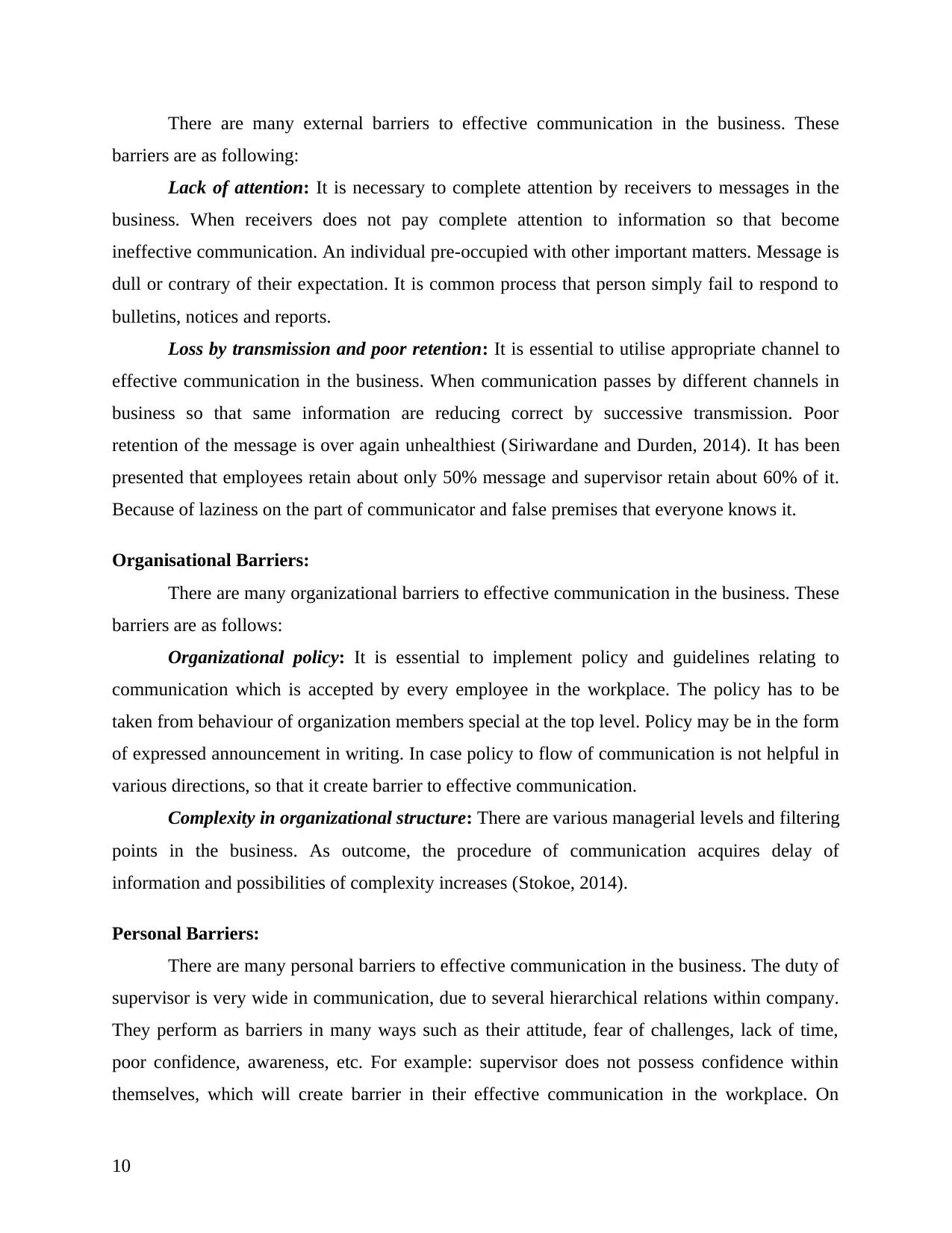
There are many external barriers to effective communication in the business. These
barriers are as following:
Lack of attention: It is necessary to complete attention by receivers to messages in the
business. When receivers does not pay complete attention to information so that become
ineffective communication. An individual pre-occupied with other important matters. Message is
dull or contrary of their expectation. It is common process that person simply fail to respond to
bulletins, notices and reports.
Loss by transmission and poor retention: It is essential to utilise appropriate channel to
effective communication in the business. When communication passes by different channels in
business so that same information are reducing correct by successive transmission. Poor
retention of the message is over again unhealthiest (Siriwardane and Durden, 2014). It has been
presented that employees retain about only 50% message and supervisor retain about 60% of it.
Because of laziness on the part of communicator and false premises that everyone knows it.
Organisational Barriers:
There are many organizational barriers to effective communication in the business. These
barriers are as follows:
Organizational policy: It is essential to implement policy and guidelines relating to
communication which is accepted by every employee in the workplace. The policy has to be
taken from behaviour of organization members special at the top level. Policy may be in the form
of expressed announcement in writing. In case policy to flow of communication is not helpful in
various directions, so that it create barrier to effective communication.
Complexity in organizational structure: There are various managerial levels and filtering
points in the business. As outcome, the procedure of communication acquires delay of
information and possibilities of complexity increases (Stokoe, 2014).
Personal Barriers:
There are many personal barriers to effective communication in the business. The duty of
supervisor is very wide in communication, due to several hierarchical relations within company.
They perform as barriers in many ways such as their attitude, fear of challenges, lack of time,
poor confidence, awareness, etc. For example: supervisor does not possess confidence within
themselves, which will create barrier in their effective communication in the workplace. On
10
barriers are as following:
Lack of attention: It is necessary to complete attention by receivers to messages in the
business. When receivers does not pay complete attention to information so that become
ineffective communication. An individual pre-occupied with other important matters. Message is
dull or contrary of their expectation. It is common process that person simply fail to respond to
bulletins, notices and reports.
Loss by transmission and poor retention: It is essential to utilise appropriate channel to
effective communication in the business. When communication passes by different channels in
business so that same information are reducing correct by successive transmission. Poor
retention of the message is over again unhealthiest (Siriwardane and Durden, 2014). It has been
presented that employees retain about only 50% message and supervisor retain about 60% of it.
Because of laziness on the part of communicator and false premises that everyone knows it.
Organisational Barriers:
There are many organizational barriers to effective communication in the business. These
barriers are as follows:
Organizational policy: It is essential to implement policy and guidelines relating to
communication which is accepted by every employee in the workplace. The policy has to be
taken from behaviour of organization members special at the top level. Policy may be in the form
of expressed announcement in writing. In case policy to flow of communication is not helpful in
various directions, so that it create barrier to effective communication.
Complexity in organizational structure: There are various managerial levels and filtering
points in the business. As outcome, the procedure of communication acquires delay of
information and possibilities of complexity increases (Stokoe, 2014).
Personal Barriers:
There are many personal barriers to effective communication in the business. The duty of
supervisor is very wide in communication, due to several hierarchical relations within company.
They perform as barriers in many ways such as their attitude, fear of challenges, lack of time,
poor confidence, awareness, etc. For example: supervisor does not possess confidence within
themselves, which will create barrier in their effective communication in the workplace. On
10
Paraphrase This Document
Need a fresh take? Get an instant paraphrase of this document with our AI Paraphraser
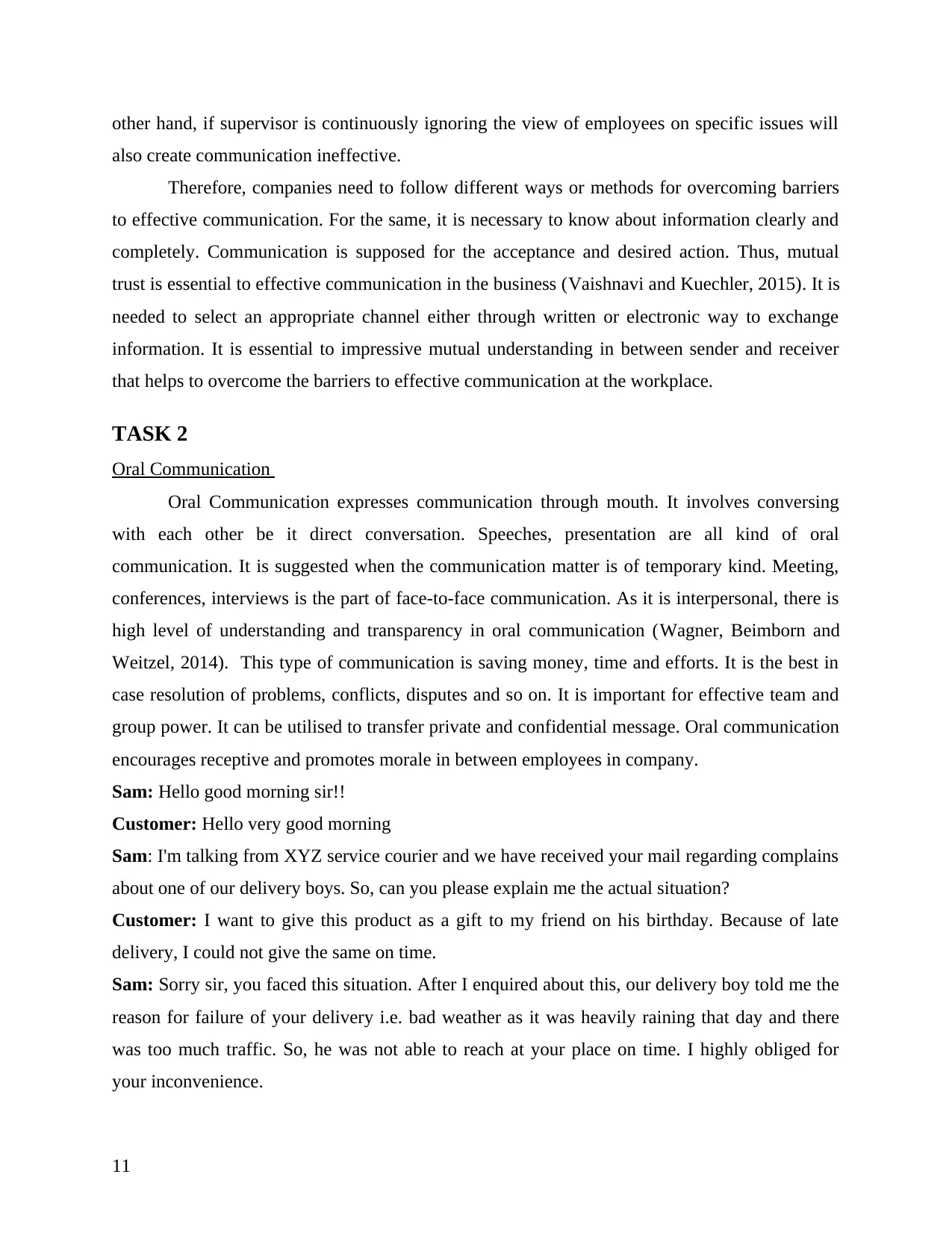
other hand, if supervisor is continuously ignoring the view of employees on specific issues will
also create communication ineffective.
Therefore, companies need to follow different ways or methods for overcoming barriers
to effective communication. For the same, it is necessary to know about information clearly and
completely. Communication is supposed for the acceptance and desired action. Thus, mutual
trust is essential to effective communication in the business (Vaishnavi and Kuechler, 2015). It is
needed to select an appropriate channel either through written or electronic way to exchange
information. It is essential to impressive mutual understanding in between sender and receiver
that helps to overcome the barriers to effective communication at the workplace.
TASK 2
Oral Communication
Oral Communication expresses communication through mouth. It involves conversing
with each other be it direct conversation. Speeches, presentation are all kind of oral
communication. It is suggested when the communication matter is of temporary kind. Meeting,
conferences, interviews is the part of face-to-face communication. As it is interpersonal, there is
high level of understanding and transparency in oral communication (Wagner, Beimborn and
Weitzel, 2014). This type of communication is saving money, time and efforts. It is the best in
case resolution of problems, conflicts, disputes and so on. It is important for effective team and
group power. It can be utilised to transfer private and confidential message. Oral communication
encourages receptive and promotes morale in between employees in company.
Sam: Hello good morning sir!!
Customer: Hello very good morning
Sam: I'm talking from XYZ service courier and we have received your mail regarding complains
about one of our delivery boys. So, can you please explain me the actual situation?
Customer: I want to give this product as a gift to my friend on his birthday. Because of late
delivery, I could not give the same on time.
Sam: Sorry sir, you faced this situation. After I enquired about this, our delivery boy told me the
reason for failure of your delivery i.e. bad weather as it was heavily raining that day and there
was too much traffic. So, he was not able to reach at your place on time. I highly obliged for
your inconvenience.
11
also create communication ineffective.
Therefore, companies need to follow different ways or methods for overcoming barriers
to effective communication. For the same, it is necessary to know about information clearly and
completely. Communication is supposed for the acceptance and desired action. Thus, mutual
trust is essential to effective communication in the business (Vaishnavi and Kuechler, 2015). It is
needed to select an appropriate channel either through written or electronic way to exchange
information. It is essential to impressive mutual understanding in between sender and receiver
that helps to overcome the barriers to effective communication at the workplace.
TASK 2
Oral Communication
Oral Communication expresses communication through mouth. It involves conversing
with each other be it direct conversation. Speeches, presentation are all kind of oral
communication. It is suggested when the communication matter is of temporary kind. Meeting,
conferences, interviews is the part of face-to-face communication. As it is interpersonal, there is
high level of understanding and transparency in oral communication (Wagner, Beimborn and
Weitzel, 2014). This type of communication is saving money, time and efforts. It is the best in
case resolution of problems, conflicts, disputes and so on. It is important for effective team and
group power. It can be utilised to transfer private and confidential message. Oral communication
encourages receptive and promotes morale in between employees in company.
Sam: Hello good morning sir!!
Customer: Hello very good morning
Sam: I'm talking from XYZ service courier and we have received your mail regarding complains
about one of our delivery boys. So, can you please explain me the actual situation?
Customer: I want to give this product as a gift to my friend on his birthday. Because of late
delivery, I could not give the same on time.
Sam: Sorry sir, you faced this situation. After I enquired about this, our delivery boy told me the
reason for failure of your delivery i.e. bad weather as it was heavily raining that day and there
was too much traffic. So, he was not able to reach at your place on time. I highly obliged for
your inconvenience.
11
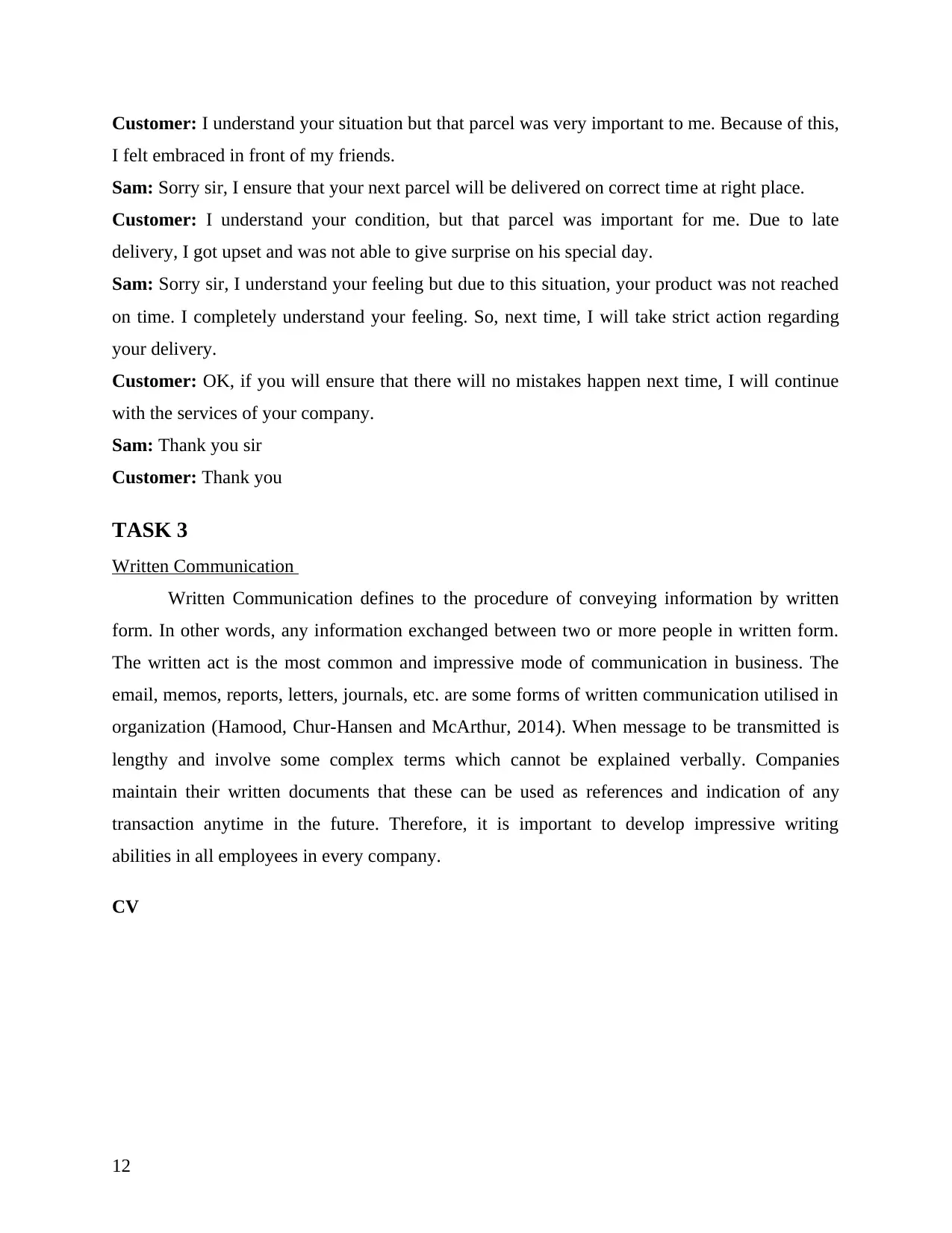
Customer: I understand your situation but that parcel was very important to me. Because of this,
I felt embraced in front of my friends.
Sam: Sorry sir, I ensure that your next parcel will be delivered on correct time at right place.
Customer: I understand your condition, but that parcel was important for me. Due to late
delivery, I got upset and was not able to give surprise on his special day.
Sam: Sorry sir, I understand your feeling but due to this situation, your product was not reached
on time. I completely understand your feeling. So, next time, I will take strict action regarding
your delivery.
Customer: OK, if you will ensure that there will no mistakes happen next time, I will continue
with the services of your company.
Sam: Thank you sir
Customer: Thank you
TASK 3
Written Communication
Written Communication defines to the procedure of conveying information by written
form. In other words, any information exchanged between two or more people in written form.
The written act is the most common and impressive mode of communication in business. The
email, memos, reports, letters, journals, etc. are some forms of written communication utilised in
organization (Hamood, Chur-Hansen and McArthur, 2014). When message to be transmitted is
lengthy and involve some complex terms which cannot be explained verbally. Companies
maintain their written documents that these can be used as references and indication of any
transaction anytime in the future. Therefore, it is important to develop impressive writing
abilities in all employees in every company.
CV
12
I felt embraced in front of my friends.
Sam: Sorry sir, I ensure that your next parcel will be delivered on correct time at right place.
Customer: I understand your condition, but that parcel was important for me. Due to late
delivery, I got upset and was not able to give surprise on his special day.
Sam: Sorry sir, I understand your feeling but due to this situation, your product was not reached
on time. I completely understand your feeling. So, next time, I will take strict action regarding
your delivery.
Customer: OK, if you will ensure that there will no mistakes happen next time, I will continue
with the services of your company.
Sam: Thank you sir
Customer: Thank you
TASK 3
Written Communication
Written Communication defines to the procedure of conveying information by written
form. In other words, any information exchanged between two or more people in written form.
The written act is the most common and impressive mode of communication in business. The
email, memos, reports, letters, journals, etc. are some forms of written communication utilised in
organization (Hamood, Chur-Hansen and McArthur, 2014). When message to be transmitted is
lengthy and involve some complex terms which cannot be explained verbally. Companies
maintain their written documents that these can be used as references and indication of any
transaction anytime in the future. Therefore, it is important to develop impressive writing
abilities in all employees in every company.
CV
12
⊘ This is a preview!⊘
Do you want full access?
Subscribe today to unlock all pages.

Trusted by 1+ million students worldwide
1 out of 17
Related Documents
Your All-in-One AI-Powered Toolkit for Academic Success.
+13062052269
info@desklib.com
Available 24*7 on WhatsApp / Email
![[object Object]](/_next/static/media/star-bottom.7253800d.svg)
Unlock your academic potential
Copyright © 2020–2025 A2Z Services. All Rights Reserved. Developed and managed by ZUCOL.





